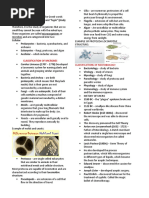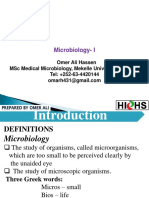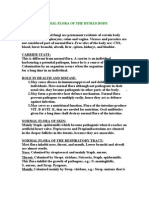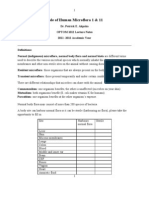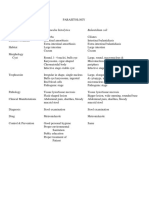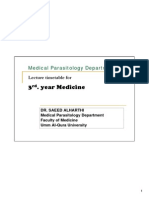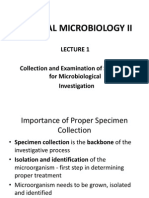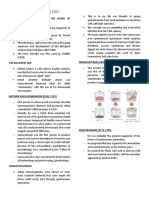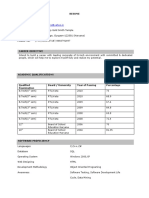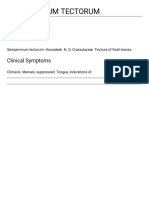0 ratings0% found this document useful (0 votes)
149 viewsMicrobiology Notes
Microbiology Notes
Uploaded by
Glecy Ann MagnoThis document provides an overview of microbiology and parasitology. It defines microbiology as the study of microbes, which are microscopic living organisms including bacteria, archaea, fungi, protozoa, and viruses. Microbes can be either cellular or acellular. They are found virtually everywhere and play many important roles in environments, industries, and human health. The document outlines some pioneers in microbiology, such as Anton van Leeuwenhoek and Louis Pasteur, and discusses various career paths in the field. It also provides brief descriptions of different types of microscopes used to study microbes.
Copyright:
© All Rights Reserved
Available Formats
Download as DOCX, PDF, TXT or read online from Scribd
Microbiology Notes
Microbiology Notes
Uploaded by
Glecy Ann Magno0 ratings0% found this document useful (0 votes)
149 views1 pageThis document provides an overview of microbiology and parasitology. It defines microbiology as the study of microbes, which are microscopic living organisms including bacteria, archaea, fungi, protozoa, and viruses. Microbes can be either cellular or acellular. They are found virtually everywhere and play many important roles in environments, industries, and human health. The document outlines some pioneers in microbiology, such as Anton van Leeuwenhoek and Louis Pasteur, and discusses various career paths in the field. It also provides brief descriptions of different types of microscopes used to study microbes.
Original Title
MICROBIOLOGY NOTES
Copyright
© © All Rights Reserved
Available Formats
DOCX, PDF, TXT or read online from Scribd
Share this document
Did you find this document useful?
Is this content inappropriate?
This document provides an overview of microbiology and parasitology. It defines microbiology as the study of microbes, which are microscopic living organisms including bacteria, archaea, fungi, protozoa, and viruses. Microbes can be either cellular or acellular. They are found virtually everywhere and play many important roles in environments, industries, and human health. The document outlines some pioneers in microbiology, such as Anton van Leeuwenhoek and Louis Pasteur, and discusses various career paths in the field. It also provides brief descriptions of different types of microscopes used to study microbes.
Copyright:
© All Rights Reserved
Available Formats
Download as DOCX, PDF, TXT or read online from Scribd
Download as docx, pdf, or txt
0 ratings0% found this document useful (0 votes)
149 views1 pageMicrobiology Notes
Microbiology Notes
Uploaded by
Glecy Ann MagnoThis document provides an overview of microbiology and parasitology. It defines microbiology as the study of microbes, which are microscopic living organisms including bacteria, archaea, fungi, protozoa, and viruses. Microbes can be either cellular or acellular. They are found virtually everywhere and play many important roles in environments, industries, and human health. The document outlines some pioneers in microbiology, such as Anton van Leeuwenhoek and Louis Pasteur, and discusses various career paths in the field. It also provides brief descriptions of different types of microscopes used to study microbes.
Copyright:
© All Rights Reserved
Available Formats
Download as DOCX, PDF, TXT or read online from Scribd
Download as docx, pdf, or txt
You are on page 1of 1
MICROBIOLOGY & PARASITOLOGY LEC
UNIT 1
CHAPTER 1 antibiotic industries and in genetic
Biology - study of living organisms engineering.
Microbiology - study of microbes, In genetic engineering, a gene(s) from
which are extremely small one organism is inserted into a
(microscopic) living organisms and bacterial or yeast cell; the cell that
certain non-living entities. receives the new gene(s) is then
Living microbes - known as cellular capable of producing the gene
microbes or microorganisms; examples product(s) coded for by the new
include bacteria, archaea, some algae, gene(s).
protozoa, and some fungi. Biotechnology - use of living organisms
Nonliving microbes - known as as their derivatives to modify products
acellular microbes or infectious Fossils of primitive microorganisms
particles; examples include viroids, date back about 3.5 billion years.
prions, and viruses. Archaea & cyanobacteria - first
Microbes are ubiquitous (i.e., they are microorganism on Earth
found virtually everywhere) Earliest known account of pestilence
Microbes - ACELLUAR INFECTOUS occurred in Egypt in about 3180 BC.
AGENTS : prions, viruses
CELLULAR MIRCROORGANISMS : PIONEERS IN THE SCIENCE OF
PROKARYOTES: archaea, bacteria MICROBIOLOGY
EUKARYOTES: algae, fungi, protozoa Anton Van Leeuwenhoek - “father of
Germs(PATHOGENS )- microbes that microbiology” made many simple
cause diseases single -lens microscope, observed
Non - pathogens - do not cause disease animalcules (bacteria or protozoa)
Indigenous microbiota - microbes live Louis Pasteur - french chemist,
on & in in our body investigated different fermentation ,
Opportunistic pathogens - can cause pasteurization , discovered life forms
disease, but usually do not that could not exists without oxygen
Infectious disease - colonize persons Robert Koch - german physician,
body, causes diseases, Ex: MRSA develop methods of fixing & staining
infection , gas gangrene bacteria & cultivate bacteria
Photo synthetic algae & CARRERS IN MICROBIOLOGY
bacteria(cyanobacteria) - produce Microbiologists - studies microbes
oxygen in atmosphere Medical microbiology - study of
Microorganisms are involved in the pathogens ,disease,defenses
decomposition of dead organisms and
waste products. CHAPTER 2
Bioremediation - clean up toxic wastes MICROSCOPE
Saprophytes - organisms live on dead - Simple microscope
or decaying organic matter - Compound microscope
Algae and bacteria serve as food for - Electron microscope
tiny animals; they are important links - Atomic force microscope
in food chains
For many years, microorganisms have Metric units - express the size of
been used as“cell models”; the more microscope
the scientists learned about microbial Micrometers - bacteria & protozoa
cells, the more they learned about cells 1 um - typical spherical
in general. bacterium(coccus)
Microbes are used in many industries, 1 um wide x 3um long - typical rod-
such as food, beverage, chemical, and shaped (baccil)
You might also like
- BS EN 1291-Mpi Acceptance Levels of Welds PDFDocument11 pagesBS EN 1291-Mpi Acceptance Levels of Welds PDFmaguenhoyos100% (1)
- MicrobiologyDocument4 pagesMicrobiologyHannah Grace CorveraNo ratings yet
- Sample GAIN Benchmarking Survey ReportDocument11 pagesSample GAIN Benchmarking Survey ReportVeena Hingarh0% (1)
- Instant Notes On Microbiology For Cerficate Level StudentDocument33 pagesInstant Notes On Microbiology For Cerficate Level StudentYogendra ShahNo ratings yet
- Chapter 1: MicrobiologyDocument18 pagesChapter 1: MicrobiologyShanz HadjirulNo ratings yet
- Micro Zoubi PDFDocument73 pagesMicro Zoubi PDFVims BatchNo ratings yet
- Ncm101 Microbiology Prelims (Lecture)Document31 pagesNcm101 Microbiology Prelims (Lecture)k78cwhs6v7No ratings yet
- Microbiology (Trans) First PartDocument4 pagesMicrobiology (Trans) First PartKristel Edds TiangsingNo ratings yet
- History of Microbiology 16th CENTURYDocument3 pagesHistory of Microbiology 16th CENTURYMeangel QuillaoNo ratings yet
- (Para) Introduction To Parasitology and Protozoology-Dr. Dela Rosa (Tiglao)Document7 pages(Para) Introduction To Parasitology and Protozoology-Dr. Dela Rosa (Tiglao)Arlene DaroNo ratings yet
- 1-Introduction To MicrobiologyDocument43 pages1-Introduction To MicrobiologyMaria AhmedNo ratings yet
- Normal Flora of The Human BodyDocument4 pagesNormal Flora of The Human BodySuzan MatarNo ratings yet
- Microbiology PDFDocument71 pagesMicrobiology PDFDanny Alexander TullumeNo ratings yet
- MicrobiologyDocument9 pagesMicrobiologyWenxinn JCFNo ratings yet
- Micro by DR - Hesham (GIT)Document65 pagesMicro by DR - Hesham (GIT)abcde990075No ratings yet
- Nematodes-Reviewer (Revised)Document4 pagesNematodes-Reviewer (Revised)Primo GeorgeNo ratings yet
- Nematode Common Name Associated Disease Mode of Transmission Habitat Definitive Host Intermediate HostDocument5 pagesNematode Common Name Associated Disease Mode of Transmission Habitat Definitive Host Intermediate HostAnjelo PerenNo ratings yet
- FAQ in MicrobiologyDocument117 pagesFAQ in MicrobiologyVenkatesh Arumugam100% (2)
- BacteriologyDocument149 pagesBacteriologyDeynielle Keith B. TiwagNo ratings yet
- Microbiology and ParasitologyDocument10 pagesMicrobiology and ParasitologyjasmineNo ratings yet
- Normal Body Flora - Beneficial EffectsDocument10 pagesNormal Body Flora - Beneficial EffectsVitrana SankarNo ratings yet
- HISTO-S01-T01-Histology & Its Methods of StudyDocument5 pagesHISTO-S01-T01-Histology & Its Methods of StudyShelahNo ratings yet
- Antimicrobial Susceptibility TestDocument4 pagesAntimicrobial Susceptibility TestMATTHEW EARL MALUMAY100% (1)
- Parasitology TableDocument15 pagesParasitology TableJohn Benedict BondocNo ratings yet
- Introduction To Pathology: DR AL Munawir, Ph.D. Lab. Patologi Anatomi FK Universitas JemberDocument30 pagesIntroduction To Pathology: DR AL Munawir, Ph.D. Lab. Patologi Anatomi FK Universitas JemberEvans Hansen100% (1)
- 1 IntroDocument5 pages1 IntroJeanjayannseptoeman100% (1)
- PMLS 2 PrelimsDocument55 pagesPMLS 2 PrelimsCassey Stephane PinedaNo ratings yet
- PMLS 1Document14 pagesPMLS 1AelwenNo ratings yet
- Pharma Unit 1-2 Anti - Adrenergic DrugsDocument21 pagesPharma Unit 1-2 Anti - Adrenergic DrugsMIbrahimNo ratings yet
- The Language of AnatomyDocument23 pagesThe Language of AnatomyKenneth Reigne ArguidasNo ratings yet
- My CologyDocument25 pagesMy CologyPlasma CarwashNo ratings yet
- Morpholofy of MoDocument44 pagesMorpholofy of MoPathumavathy RamanathanNo ratings yet
- Intro To MycoDocument6 pagesIntro To Mycojohn hector regpalaNo ratings yet
- Clinical Parasitology TableDocument3 pagesClinical Parasitology TableJajaAbanaNo ratings yet
- Respiratory Infections ....Document195 pagesRespiratory Infections ....Poorny PurushothNo ratings yet
- HistotechniquesDocument9 pagesHistotechniquesDivineGloryMalbuyoNo ratings yet
- Bacteria - Morphology & ClassificationDocument38 pagesBacteria - Morphology & ClassificationAfshan NasirNo ratings yet
- Lesson 2 - Nematodes. Nematodes Common Name Mode of Transmission Habitat Infective Stage Diagnostic Stage Definitive Host Intermediate HostDocument2 pagesLesson 2 - Nematodes. Nematodes Common Name Mode of Transmission Habitat Infective Stage Diagnostic Stage Definitive Host Intermediate HostAnjelo PerenNo ratings yet
- Test Questionairre FormatDocument149 pagesTest Questionairre FormatSantosh Kumar TataNo ratings yet
- Antimicrobial Susceptibility TestingDocument30 pagesAntimicrobial Susceptibility TestingDax Liwell SalesNo ratings yet
- Parasitology: Tretamodes: Lung Flukes and OthersDocument9 pagesParasitology: Tretamodes: Lung Flukes and OthersJoan Caacbay De GuzmanNo ratings yet
- Introduction of ParasitologyDocument47 pagesIntroduction of ParasitologyNadiya Afifah100% (1)
- Introduction To MicrobiologyDocument51 pagesIntroduction To MicrobiologyGabz GabbyNo ratings yet
- Lesson 4Document6 pagesLesson 4doldol ocampoNo ratings yet
- Chapter 20. Infections of The Urinary TractDocument8 pagesChapter 20. Infections of The Urinary TractZin Lim100% (1)
- Lecture 1 - Introduction To MicrobiologyDocument27 pagesLecture 1 - Introduction To Microbiologyapi-3703352100% (5)
- Anaerobic Culture .: Ahmed GomaaDocument42 pagesAnaerobic Culture .: Ahmed Gomaaah7510No ratings yet
- Antimicrobial Susceptibility TestingDocument23 pagesAntimicrobial Susceptibility TestingLyz Bernardino100% (1)
- Medical Microbiology II Lecture 1Document55 pagesMedical Microbiology II Lecture 1CarinaJongLeeNo ratings yet
- Medical MycologyDocument54 pagesMedical Mycologysuwarny100% (1)
- ParasitologyDocument107 pagesParasitologyShimelis Teshome AyalnehNo ratings yet
- MicroparasitologyDocument28 pagesMicroparasitologyMj BrionesNo ratings yet
- ConnectivetissuepptDocument20 pagesConnectivetissuepptChicco De AngelisNo ratings yet
- Bacteriology PDFDocument226 pagesBacteriology PDFWaseem Ur RahmanNo ratings yet
- Microbiology Parasitology NotesDocument60 pagesMicrobiology Parasitology Notesaramargareth31100% (1)
- MICRO (1) Fundamentals of Microbiology - Dra - AbuevaDocument16 pagesMICRO (1) Fundamentals of Microbiology - Dra - AbuevaCindy Mae Macamay100% (1)
- Regional Anatomy Question - FinalDocument8 pagesRegional Anatomy Question - FinalManju ShreeNo ratings yet
- History of MicrobiologyDocument5 pagesHistory of MicrobiologyBernadine EliseNo ratings yet
- Mycobacteria: Molecular Biology and VirulenceFrom EverandMycobacteria: Molecular Biology and VirulenceC. RatledgeNo ratings yet
- Chapter 1 MicroparaDocument3 pagesChapter 1 MicroparaJun Elbert JaboliNo ratings yet
- Chapter 1Document4 pagesChapter 1Shane TamilNo ratings yet
- Ssci7 Life and Works of Rizal: Module 3: Pilipinas, Espanya, at Buhay Sa Kolonya (Philippines in 19Th Century)Document4 pagesSsci7 Life and Works of Rizal: Module 3: Pilipinas, Espanya, at Buhay Sa Kolonya (Philippines in 19Th Century)Glecy Ann MagnoNo ratings yet
- Ssci7 Life and Works of Rizal: Racial OriginDocument2 pagesSsci7 Life and Works of Rizal: Racial OriginGlecy Ann MagnoNo ratings yet
- M4LWOFRIZALDocument3 pagesM4LWOFRIZALGlecy Ann MagnoNo ratings yet
- Purposive - Module 1Document4 pagesPurposive - Module 1Glecy Ann MagnoNo ratings yet
- M1 LwofrizalDocument3 pagesM1 LwofrizalGlecy Ann MagnoNo ratings yet
- Ha NotesDocument39 pagesHa NotesGlecy Ann MagnoNo ratings yet
- Grade 10 HSB End of TermDocument10 pagesGrade 10 HSB End of TermCHRISTOPHER SCALENo ratings yet
- Advocacy SpeechDocument4 pagesAdvocacy Speechapi-357041339No ratings yet
- Coolvicky - Sony@yahoo - In: Resume Vikas Mohan E-Mail: AddressDocument3 pagesCoolvicky - Sony@yahoo - In: Resume Vikas Mohan E-Mail: Addressvikasmohan16No ratings yet
- Itinerary: Kuala Lumpur Malaysia & Singapore: DAY 2: May 24, 2018 (FRIDAY)Document2 pagesItinerary: Kuala Lumpur Malaysia & Singapore: DAY 2: May 24, 2018 (FRIDAY)marygrace asuntoNo ratings yet
- Difference Between Profit Making and Non-Profit Making OrganisationDocument3 pagesDifference Between Profit Making and Non-Profit Making OrganisationJean EmanuelNo ratings yet
- 2019 DPWH Department OrdersDocument1,201 pages2019 DPWH Department OrdersFlash WingNo ratings yet
- IP MODEL 1 QST Set 2Document4 pagesIP MODEL 1 QST Set 2uma divanNo ratings yet
- Fs5 Episode 6Document6 pagesFs5 Episode 6Sharina Canaria ObogNo ratings yet
- INTERSUBJECTIVITYDocument2 pagesINTERSUBJECTIVITYEman NolascoNo ratings yet
- Carlite: Grain Oriented Electrical SteelsDocument27 pagesCarlite: Grain Oriented Electrical SteelsRichard SyNo ratings yet
- DVC 2019Document154 pagesDVC 2019Rishabh ShuklaNo ratings yet
- Sempervivum Tectorum: Other Names: Made FromDocument4 pagesSempervivum Tectorum: Other Names: Made FromDohn JoeNo ratings yet
- Stop Paying For Shit! - The College Edition: A Mini-Manual of Scams, Cons, and Grifts To Exploit Higher EducationDocument22 pagesStop Paying For Shit! - The College Edition: A Mini-Manual of Scams, Cons, and Grifts To Exploit Higher EducationDIzzIE97% (30)
- Final ScriptDocument144 pagesFinal ScriptBharatNo ratings yet
- Letter of Recommmendation From Stephanie GasserDocument1 pageLetter of Recommmendation From Stephanie Gasserapi-708800698No ratings yet
- Aitchison College, Lahore Prep School: Subject: History NameDocument3 pagesAitchison College, Lahore Prep School: Subject: History Nameibad k0% (1)
- Commercial Paper OutlineDocument30 pagesCommercial Paper Outlinewgearhar0% (1)
- PD Cen TR 10261-2018 PDFDocument38 pagesPD Cen TR 10261-2018 PDFMaiDuyNo ratings yet
- Global City Index: Piter BiswasDocument22 pagesGlobal City Index: Piter BiswasMel SateNo ratings yet
- Quality Assurance Manual Rev 6Document36 pagesQuality Assurance Manual Rev 6hastinkakaNo ratings yet
- Pinians Preferred Combo On Harvey'S Menu in Masantol, PampangaDocument5 pagesPinians Preferred Combo On Harvey'S Menu in Masantol, PampangaJocelyn ManuyagNo ratings yet
- WWWWDocument2 pagesWWWWohpppNo ratings yet
- Lap Keu WikaDocument192 pagesLap Keu WikassNo ratings yet
- Resume KalpeshDocument2 pagesResume Kalpeshsujal1310No ratings yet
- Dus 50 MurzanDocument2 pagesDus 50 MurzanJas SumNo ratings yet
- Requirements: Squirrelmail 1.4.6 On Redhat Linux 9 Part 1 - Installing Squirrelmail & Configuring The Apache Virtual HostDocument28 pagesRequirements: Squirrelmail 1.4.6 On Redhat Linux 9 Part 1 - Installing Squirrelmail & Configuring The Apache Virtual HostBajink Dan Ibunda TercintaNo ratings yet
- Iot SIMP Tie - 2024Document3 pagesIot SIMP Tie - 2024Anusha RNo ratings yet
- Consumer Behaviour AttitudeDocument25 pagesConsumer Behaviour AttitudeSuccess SETU Study PointNo ratings yet







